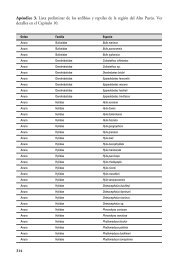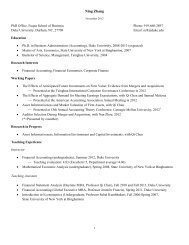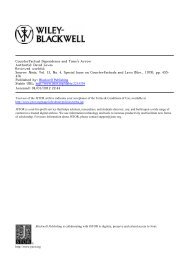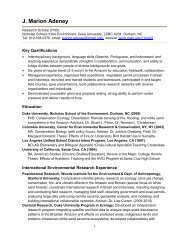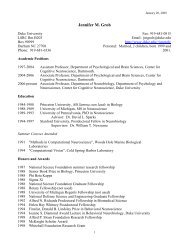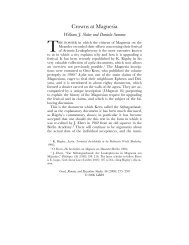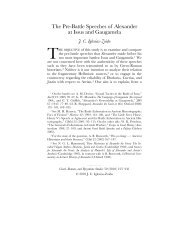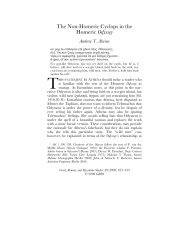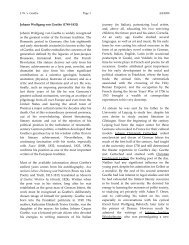Steven J. Stanton, Ph.D. - Duke University
Steven J. Stanton, Ph.D. - Duke University
Steven J. Stanton, Ph.D. - Duke University
Create successful ePaper yourself
Turn your PDF publications into a flip-book with our unique Google optimized e-Paper software.
<strong>Steven</strong> J. <strong>Stanton</strong>, <strong>Ph</strong>.D.<br />
Curriculum Vitae<br />
Updated 5-3-11<br />
<strong>Duke</strong> <strong>University</strong><br />
B203 LSRC Building, Research Dr.<br />
Box 90999<br />
Durham, NC 27708‐0999<br />
steven.stanton@duke.edu, 734‐276‐0797<br />
______________________________________________________________________________<br />
Education:<br />
2008 <strong>Ph</strong>.D. Psychology <strong>University</strong> of Michigan – Ann Arbor<br />
Dissertation Committee: O. Schultheiss (dissertation chair), T. Lee, K. Berridge, & B. Strassmann<br />
2006 M.S. Psychology <strong>University</strong> of Michigan – Ann Arbor<br />
Thesis Advisors: O. Schultheiss & D. Winter<br />
2002 B.A. Psychology and Economics <strong>University</strong> of Michigan – Ann Arbor<br />
Honors Thesis Advisor: W. McKeachie<br />
______________________________________________________________________________<br />
Positions:<br />
2008‐present Postdoctoral Fellow <strong>Duke</strong> <strong>University</strong> –<br />
Mentors: K. LaBar and S. Huettel Center for Cognitive Neuroscience<br />
______________________________________________________________________________<br />
Awards and Honors:<br />
2010 – Young Investigator Award – Society for Behavioral Neuroendocrinology<br />
2008 – Outstanding Research Award – Society for Personality and Social Psychology<br />
2008 – McClelland Foundation Postdoctoral Fellowship<br />
2008 – Nominated for the 2008 Outstanding Dissertation Award – <strong>University</strong> of Michigan<br />
2007 – Young Investigator Award – International Society of Psychoneuroendocrinology<br />
2007, 2006 – Outstanding Graduate Student Instructor Honor Roll<br />
2007, 2006, 2005 – Rackham Graduate Travel Awards<br />
2002 – James B. Angell Scholar ‐ <strong>University</strong> of Michigan<br />
2001 – <strong>University</strong> Honors – <strong>University</strong> of Michigan<br />
2000 – Class Honors – <strong>University</strong> of Michigan<br />
1998‐2002 – State of Michigan Undergraduate Scholarship<br />
1
<strong>Steven</strong> J. <strong>Stanton</strong><br />
______________________________________________________________________________<br />
Publications:<br />
2011 & In Press<br />
<strong>Stanton</strong>, S. J., Mullette‐Gillman, O. A., McLaurin, R. E., Kuhn, C. M., LaBar, K. S., Platt, M. L., &<br />
Huettel, S. A. (2011). Low and high testosterone individuals exhibit decreased aversion<br />
to economic risk. Psychological Science, 22, 447‐453.<br />
<strong>Stanton</strong>, S. J. (2011). The essential implications of gender in human behavioral endocrinology<br />
studies. Frontiers in Behavioral Neuroscience. 5:9. doi: 10.3389/fnbeh.2011.00009.<br />
<strong>Stanton</strong>, S. J., Liening, S. H., & Schultheiss, O. C. (2011). Testosterone is positively associated<br />
with risk‐taking in the Iowa Gambling Task. Hormones and Behavior, 59, 252‐256.<br />
<strong>Stanton</strong>, S. J., & Schultheiss, O. C. (2011; in press). Testosterone and power. In Dowding, K. M.<br />
(Ed.), Encyclopedia of Power. Thousand Oaks: Sage Publications.<br />
2010<br />
<strong>Stanton</strong>, S. J., LaBar, K. S., Saini, E. K., Kuhn, C. M., & Beehner, J. C. (2010). Stressful politics:<br />
Voters’ cortisol responses to the outcome of the 2008 United States Presidential<br />
election. Psychoneuroendocrinology, 35, 768‐774.<br />
<strong>Stanton</strong>, S. J., Hall, J. L., & Schultheiss, O. C. (2010). Properties of motive‐specific incentives. In<br />
O. C. Schultheiss & Brunstein, J. C. (Eds.), Implicit Motives (pp. 245‐277). New York:<br />
Cambridge <strong>University</strong> Press.<br />
Edelstein, R. S., <strong>Stanton</strong>, S. J., Henderson, M., M. & Sanders, M. R. (2010). Endogenous estradiol<br />
levels are associated with attachment avoidance and implicit intimacy motivation.<br />
Hormones and Behavior, 57, 230‐236.<br />
Liening, S. H., <strong>Stanton</strong>, S. J., Saini, E. K., & Schultheiss, O. C. (2010). Salivary testosterone,<br />
cortisol, and progesterone: two‐week stability, interhormone correlations, and effects<br />
of time of day, menstrual cycle, and oral contraceptive use on steroid hormone levels.<br />
<strong>Ph</strong>ysiology and Behavior, 99, 8‐16.<br />
Hall, J. L., <strong>Stanton</strong>, S. J., & Schultheiss, O. C. (2010). Biopsychological and neural processes of<br />
implicit motivation. In O. C. Schultheiss & Brunstein, J. C. (Eds.), Implicit Motives (pp.<br />
279‐307. New York: Cambridge <strong>University</strong> Press.<br />
2
2009<br />
<strong>Steven</strong> J. <strong>Stanton</strong><br />
<strong>Stanton</strong>, S. J., Beehner, J. C., Saini, E. K., Kuhn, C. M., & LaBar, K. S. (2009). Dominance, politics,<br />
and physiology: Voters’ testosterone changes on the night of the 2008 United States<br />
Presidential election. PLoS ONE 4(10): e7543. doi:10.1371/journal.pone.0007543<br />
<strong>Stanton</strong>, S. J, & Edelstein, R. S. (2009). The physiology of women’s implicit power motive:<br />
Implicit power motivation is positively associated with estradiol levels in women.<br />
Journal of Research in Personality, 43, 1109‐1113.<br />
<strong>Stanton</strong>, S. J., & Schultheiss, O. C. (2009). The hormonal correlates of implicit power<br />
motivation. Journal of Research in Personality, 43, 942‐949.<br />
<strong>Stanton</strong>, S. J., Wirth, M. M., Waugh, C. E., & Schultheiss, O. C., (2009). Endogenous testosterone<br />
levels predict amygdala response to dominance signals in men. Biological Psychology,<br />
81, 118‐122.<br />
Schultheiss, O. C., & <strong>Stanton</strong>, S. J. (2009). Assessment of salivary hormones. In Harmon‐Jones,<br />
E & Beer, J. (Eds.), Methods in the neurobiology of social and personality psychology (pp.<br />
17‐ 44). New York, NY: Guilford.<br />
2008<br />
Schultheiss, O. C., Wirth, M. M., Waugh, C. E., <strong>Stanton</strong>, S. J., Meier, E. A., & Reuter‐Lorenz, P.<br />
(2008). Effects of implicit motives on brain activation in response to facial expressions of<br />
emotion: An fMRI investigation. Social Cognitive and Affective Neuroscience, 3, 333‐343.<br />
2007<br />
<strong>Stanton</strong>, S. J., & Schultheiss, O. C. (2007). Basal and dynamic associations between implicit<br />
power motivation and estradiol in women. Hormones and Behavior, 52(5), 571‐580.<br />
2004<br />
Schultheiss, O. C., Wirth, M. M., & <strong>Stanton</strong>, S. J. (2004). Effects of affiliation and power<br />
motivation arousal on salivary progesterone and testosterone. Hormones and Behavior,<br />
46(5), 592‐599.<br />
Manuscripts submitted for publication:<br />
Rösch, A. G., <strong>Stanton</strong>, S. J., & Schultheiss, O. C. (submitted). Valence and arousal ratings of<br />
facial expressions of emotion: Effects of viewers’ implicit motives and gender.<br />
3
<strong>Steven</strong> J. <strong>Stanton</strong><br />
<strong>Stanton</strong>, S. J., Reeck, C. L. C., Huettel, S. A., & LaBar, K. S. (submitted). How your mood can<br />
change your mind: Incidental affect imparts long‐term changes in economic decision<br />
making.<br />
<strong>Stanton</strong>, S. J., Mullette‐Gillman, O. A., Huettel, S. A. (submitted). Circannual variation of salivary<br />
testosterone in men, normally‐cycling women, and women using hormonal<br />
contraceptives.<br />
Wood, R. I., & <strong>Stanton</strong>, S. J. (submitted). Testosterone in sport: current cases.<br />
Manuscripts in preparation:<br />
<strong>Stanton</strong>, S. J. (in preparation). The neuroendocrinology of dominance in humans.<br />
Paul, N., <strong>Stanton</strong>, S.J., Greenson, J. , Smoski, M., Wang, L. (in preparation). Psychological and<br />
neural mechanisms of non‐reactivity in preventing stress.<br />
Rosenthal, M.Z., Bagwell, J., Brady, R., LaBar, K.S., Zielinski, D., Thompson, H., <strong>Stanton</strong>, S. J.,<br />
Kim, K. (in preparation). Preliminary validation of a fully immersive virtual home<br />
environment as a platform for measurement of emotional reactivity and regulation.<br />
______________________________________________________________________________<br />
Invited conference talks and lectures:<br />
<strong>Stanton</strong>, S. J., LaBar, K. S., & Huettel, S. A. (2011). Testosterone’s relationship with politics and<br />
economics: social and personality psychology perspectives. Invited talk presented at the<br />
Society for Personality and Social Psychology Conference: San Antonio, TX.<br />
<strong>Stanton</strong>, S. J., (2011). Neuroendocrine markers of social dominance and risky decision making in<br />
humans. Invited talk presented at the Social Psychology Colloquium: <strong>University</strong> of<br />
Virginia, Charlottesville.<br />
<strong>Stanton</strong>, S. J. (2011). Neuroendocrine markers of social dominance and risky decision making in<br />
humans. Invited talk presented at the Emerging themes in Social Neuroscience series:<br />
<strong>Duke</strong> <strong>University</strong>.<br />
<strong>Stanton</strong>, S. J., Schultheiss, O. C., & LaBar, K. S. (2010). Sexually‐dimorphic relationships between<br />
steroids and dominance in humans: Evidence from politics, neuroimaging, and<br />
dominance competition. Invited talk presented at the Young Investigator Award<br />
Symposium at the Society for Behavioral Neuroendocrinology Conference: Toronto, CA.<br />
<strong>Stanton</strong>, S. J. (2010). Is estrogen the biological correlate of power motivation in women? Invited<br />
talk presented at the Society for the Study of Motivation Conference: Boston, MA.<br />
<strong>Stanton</strong>, S. J., & Schultheiss, O. C. (2009). Hormones and power motivation in women: the role<br />
of estrogen. Invited talk presented at the Outstanding Research Award symposium of<br />
the Society for Personality and Social Psychology Conference: Tampa, FL.<br />
4
<strong>Steven</strong> J. <strong>Stanton</strong><br />
<strong>Stanton</strong>, S. J., & Schultheiss, O. C. (2008). Basal and dynamic associations between implicit<br />
power motivation and estradiol in women. Invited talk presented at the Social<br />
Endocrinology symposium of the Society for Personality and Social Psychology<br />
Conference: Albuquerque, NM.<br />
<strong>Stanton</strong>, S. J. (2008). Testosterone. Invited talk presented in “The Psychology of Masculinity”:<br />
<strong>University</strong> of Michigan, Ann Arbor.<br />
<strong>Stanton</strong>, S. J. (2007). Brain activation in response to facial expressions of anger: the role of<br />
testosterone. Invited talk presented at the Social, Cognitive, and Affective Neuroscience<br />
colloquium: <strong>University</strong> of Michigan, Ann Arbor.<br />
<strong>Stanton</strong>, S. J., Wirth, M. M., Waugh, C. E., Reuter‐Lorenz, P. A., Schultheiss, O. C. (2007). Effects<br />
of testosterone and cortisol on brain activation in response to facial expressions of<br />
anger: An fMRI investigation. Invited talk presented at the Young Investigator<br />
Symposium of the International Society for Psychoneuroendocrinology Conference:<br />
Madison, Wisconsin.<br />
<strong>Stanton</strong>, S. J. (2006). Implicit Sexual Motivation: Measure development with behavioral and<br />
physiological validation. Invited talk presented at the Personality and Social Context<br />
Colloquium: Department of Psychology, <strong>University</strong> of Michigan, Ann Arbor.<br />
<strong>Stanton</strong>, S. J. (2005). Effects of gonadal steroids and implicit motives on Pavlovian<br />
conditioning with facial expressions of emotion in humans. Invited talk presented at the<br />
Biopsychology Colloquium: Department of Psychology, <strong>University</strong> of Michigan, Ann<br />
Arbor.<br />
<strong>Stanton</strong>, S. J. (2002). Human Motivation. Invited talk presented in “Honors Introduction to<br />
Psychology”: <strong>University</strong> of Michigan, Ann Arbor.<br />
______________________________________________________________________________<br />
Conference poster presentations:<br />
<strong>Stanton</strong>, S. J., Reeck, C. L. C. Huettel, S. A., & LaBar, K. S. (2010). How your mood can change<br />
your mind: Incidental affect imparts long‐term changes in economic decision making.<br />
Poster to be presented at the Social and Affective Neuroscience conference, Chicago, IL.<br />
<strong>Stanton</strong>, S. J., Mullette‐Gillman, O. A., McLaurin, R. E., Kuhn, C. M., LaBar, K. S., Platt, M. L., &<br />
Huettel, S. A. (2010). Endogenous testosterone has an inverted‐U relationship with<br />
financial risk preferences in both men and women. Poster to be presented at the Society<br />
for Neuroscience conference, San Diego, CA.<br />
<strong>Stanton</strong>, S. J., Beehner, J. C., Saini, E. K., Kuhn, C. M., & LaBar, K. S. (2009). Do politics get your<br />
hormones going? Voters’ testosterone and cortisol responses to the outcome of the 2008<br />
United States Presidential election. Poster presented at the Social and Affective<br />
Neuroscience conference, New York, NY.<br />
<strong>Stanton</strong>, S. J., Beehner, J. C., Saini, E. K., Kuhn, C. M., & LaBar, K. S. (2009). Do politics get your<br />
hormones going? Voters’ testosterone and cortisol responses to the outcome of the 2008<br />
United States Presidential election. Poster presented at the annual conference for<br />
Personality and Social Psychology, Las Vegas, NV.<br />
<strong>Stanton</strong>, S. J., & Schultheiss, O. C. (2008) Basal and dynamic associations between implicit<br />
power motivation and estradiol in women. Poster presented at the Society for<br />
Personality and Social Psychology Conference, Albuquerque, NM.<br />
5
<strong>Steven</strong> J. <strong>Stanton</strong><br />
<strong>Stanton</strong>, S. J., Wirth, M. M., Waugh, C. E., Reuter‐Lorenz, P. A., Schultheiss, O. C. (2007). Effects<br />
of testosterone and cortisol on brain activation in response to facial expressions of<br />
anger: An fMRI investigation. Poster presented at the International Society for<br />
Psychoneuroendocrinology Conference: Madison, Wisconsin.<br />
Hall, J. L., <strong>Stanton</strong>, S. J., Wirth, M. M., Waugh, C. E., Reuter‐Lorenz, P. A., &<br />
Schultheiss, O. C. (2007). Implicit motivation in the brain: The role of implicit power<br />
motivation on neural responses to angry facial expressions. Talk presented at the annual<br />
convention of the Society for Psychophysiological Research, Savannah, GA.<br />
Hall, J. L., <strong>Stanton</strong>, S. J., Wirth, M. M., Waugh, C. E., Reuter‐Lorenz, P. A., &<br />
Schultheiss, O. C. (2007). Individual differences in implicit motivation: Do<br />
power and affiliation motives differentially influence responses to facial<br />
expressions of emotion. Poster presented at the annual convention of the Society for<br />
Personality and Social Psychology, Memphis, TN.<br />
Hall, J. L., <strong>Stanton</strong>, S. J., Waugh, C. E., Wirth, M. M., Reuter‐Lorenz, P. A., &<br />
Schultheiss, O. C. (2007). Cross‐cutting perspectives on motivation: The use of<br />
theories and methods from cognitive neuroscience to investigate implicit power<br />
and affiliation motivation. Poster presented at the annual convention of the<br />
Association for Psychological Science, Washington, DC.<br />
Hall, J. L., <strong>Stanton</strong>, S. J., Wirth, M. M., Waugh, C. E., Reuter‐Lorenz, P. A., &<br />
Schultheiss, O. C. (2007). Implicit power and affiliation motivation differentially<br />
predict neural activation to angry facial expressions in reward and motivational<br />
brain regions. Poster presented at the annual convention of the Cognitive Neuroscience<br />
Society, New York, NY.<br />
<strong>Stanton</strong>, S. J., Wirth, M. M., Schultheiss, O. C. (2006). Effects of perceivers’ implicit power<br />
motivation on attentional orienting to Pavlovian conditioned cues of anger and joy.<br />
Poster presented at the Society for Social and Personality Psychology conference: Palm<br />
Springs, CA.<br />
Wirth, M. M., <strong>Stanton</strong>, S. J., Waugh, C. E., Reuter‐Lorenz, P. A., Schultheiss, O. C. (2006). Brain<br />
activation in response to facial signals of dominance and submission: The role of implicit<br />
power motivation. Poster presented at the Society for Social and Personality Psychology<br />
conference: Palm Springs, CA.<br />
<strong>Stanton</strong>, S. J., Wirth, M. M., Waugh, C. E., Reuter‐Lorenz, P. A., Schultheiss, O. C. (2006). Brain<br />
activation in response to facial expressions of anger: The role of testosterone. Poster<br />
presented at the Conference for the International Society for<br />
Psychoneuroendocrinology: Leiden, The Netherlands.<br />
<strong>Stanton</strong>, S. J., Wirth, M. M., & Schultheiss, O. C. (2003). Implicit motives modulate<br />
attentional orienting to facial expressions of emotion presented sub‐ and supraliminally.<br />
Poster presented at the Kyoto <strong>University</strong> International Symposium on Self, Cognition,<br />
and Emotion: <strong>University</strong> of Michigan, Ann Arbor.<br />
6
<strong>Steven</strong> J. <strong>Stanton</strong><br />
______________________________________________________________________________<br />
Published Conference Proceedings:<br />
Hall, J. L., Waugh, C. E., <strong>Stanton</strong>, S. J., Wirth, M. M., Reuter‐Lorenz, P. A., Schultheiss, O. C.<br />
(2007). Implicit motivation in the brain: The role of implicit power and affiliation<br />
motivation on neural responses to angry facial expressions. Psychophysiology, 44, S18.<br />
Hall, J. L., Waugh, C. E., <strong>Stanton</strong>, S. J., Wirth, M. M., Reuter‐Lorenz, P. A., Schultheiss, O. C.<br />
(2007). Implicit motivation in the brain: The role of implicit power and affiliation<br />
motivation on neural responses to angry facial expressions of emotion.<br />
Psychophysiology, 44, S45<br />
______________________________________________________________________________<br />
Research Grants:<br />
2009 – <strong>Duke</strong> Institute for Brain Sciences (Co‐Investigator): “Interoception and the development<br />
of self‐regulation in adolescence” (Direct Costs: $100,000)<br />
2008 – McClelland Foundation Postdoctoral Research Fellowship (PI): “An investigation of the<br />
biological correlates of implicit power motivation” (R80 ‐ Direct Costs: $17,000)<br />
2007 – Rackham Predoctoral Fellowship ‐ $25,800<br />
2007 – Rackham Graduate Research Grant ‐ $3,000<br />
2007 – <strong>University</strong> of Michigan Psychology Dissertation Research Grant ‐ $1,000<br />
2006 – Walter M. Pillsbury Research Grant ‐ $1,000<br />
______________________________________________________________________________<br />
Teaching Experience:<br />
At the <strong>University</strong> of Michigan: 8 semesters of teaching experience<br />
Courses Taught as Graduate Student Instructor:<br />
Psychology 111: Introduction to Psychology<br />
Psychology 114: Honors Introduction to Psychology<br />
Psychology 230: Introduction to Biopsychology<br />
Psychology 442: Perception, Science, and Reality<br />
7
<strong>Steven</strong> J. <strong>Stanton</strong><br />
______________________________________________________________________________<br />
Ad Hoc Reviewer:<br />
Grants:<br />
National Science Foundation<br />
Journals:<br />
Biological Psychology, Evolution and Human Behavior, Hormones and Behavior, Journal of<br />
Research in Personality, Motivation and Emotion, Neuropsychobiology, Psychological Science,<br />
Psychoneuroendocrinology, Stress<br />
______________________________________________________________________________<br />
Professional Memberships (current and past):<br />
International Society for Psychoneuroendocrinology<br />
Social and Affective Neuroscience Society<br />
Society for Behavioral Neuroendocrinology<br />
Society for Neuroscience<br />
Society for Personality and Social Psychology<br />
____________________________________________________________________________<br />
Selected Media Coverage of Research:<br />
Television and Radio:<br />
CNN, April 30, 2011. “Your money and your brain”,<br />
http://ondemand.duke.edu/video/27750/how‐your‐mind‐processes‐invest<br />
AAAS Science Update, November 9, 2009. “Election Testosterone”,<br />
http://www.scienceupdate.com/2009/11/election‐testosterone/<br />
National Public Radio, October, 28, 2009. “Testing Testosterone”,<br />
http://wunc.org/tsot/archive/sot1028b09.mp3/view<br />
Canadian Broadcasting Centre, October 21, 2009.<br />
http://www.cbc.ca/mrl3/8752/asithappens/20091021‐aih‐2.wmv<br />
Print:<br />
New Scientist, March 24, 2011. “Low testosterone linked with financial risk‐taking”,<br />
http://www.newscientist.com/article/mg20928044.300‐low‐testosterone‐linked‐with‐financial‐<br />
risktaking.html<br />
Scientific American, October 23, 2009. “Jock the Vote: Election outcomes affect testosterone<br />
levels in men”, http://www.scientificamerican.com/article.cfm?id=vote‐election‐testosterone<br />
Science Daily, May 23, 2008. “Estrogen fuels female need for power and control”,<br />
http://www.sciencedaily.com/releases/2008/05/080522075940.htm.<br />
Reuters, April 30, 2008. “Is estrogen testosterone for women?”,<br />
http://www.reuters.com/article/healthNews/idUSN3055122720080501.<br />
MSNBC, April 30, 2008. “Estrogen fuels competitive drive in women”,<br />
8
<strong>Steven</strong> J. <strong>Stanton</strong><br />
http://www.msnbc.msn.com/id/24395334/.<br />
Telegraph, July 28, 2004. “Weepie or action movie? It’s in the hormones, says study”.<br />
http://www.telegraph.co.uk/news/worldnews/northamerica/usa/1468061/Weepie‐or‐action‐<br />
movie‐It%27s‐in‐the‐hormones%2C‐says‐study.html.<br />
WebMD, July 23, 2004. “Movies make hormones surge or fade”. http://www.webmd.com/sex‐<br />
relationships/news/20040723/movies‐make‐hormones‐surge‐fade.<br />
Science Daily, July 23, 2004. “Movies can raise or lower hormone levels”.<br />
http://www.sciencedaily.com/releases/2004/07/040722085905.htm.<br />
9



